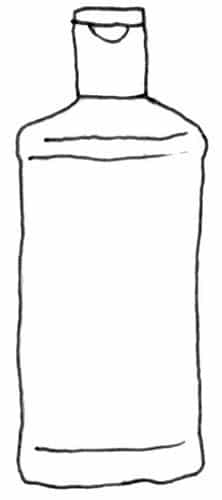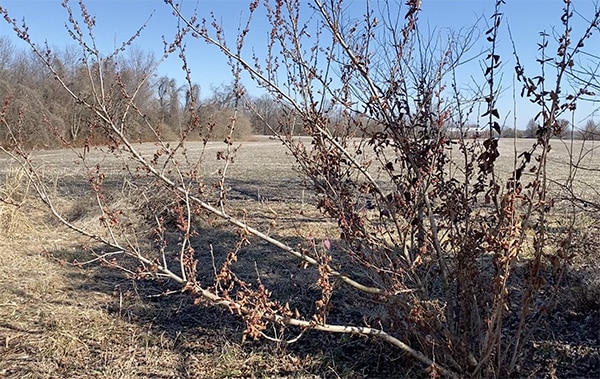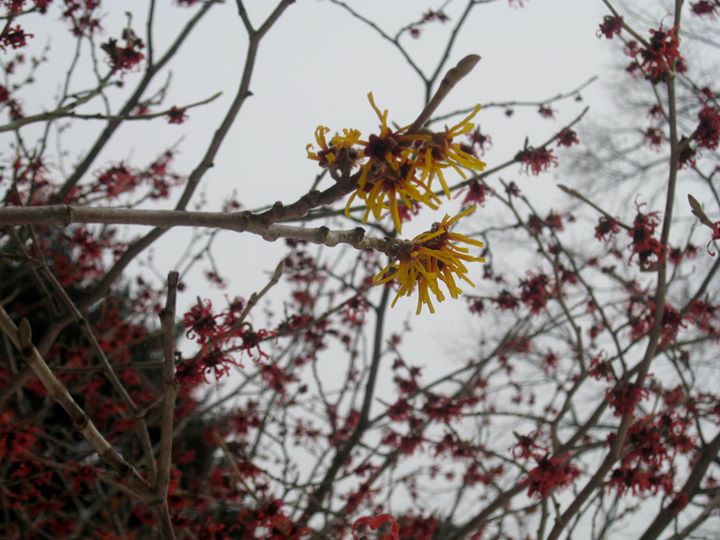Herbalist Susun Weed tells a wonderful story about the creation of Witch Hazel which describes how Witch Hazel blooms in the middle of winter. When all other plants are slumbering, Witch Hazel shows off her beauty with frilly yellow flowers, reminiscent of fireworks, exploding from her branches.

Photo by Gail Faith Edwards of Blessed Maine Herb Farm
There are other eccentricities tied to Witch Hazel’s existence as well, such as her only growing to be about 15 feet (5 meters) in height, having asymmetrical leaves and holding onto her seeds for 2 years before firing them off like cannons. But as odd as this tree is, she is probably one of the best known herbs after Echinacea in a world where herbs are common. Even more odd, Witch Hazel is one of the few herbs approved by the FDA as a tested and proven natural remedy for acne!
Witch Hazel is from her own family, Hamamelidaceae. There are three species of Witch Hazel in North America: Hamamelis virginiana, H. ovalis, and H. vernalis. There are also 2 species in Asia: H. japonica from Japan and H. mollis from China.

Witch Hazel can be found in grocery stores, drug stores and other stores that sell personal use items, usually next to rubbing alcohol and hydrogen peroxide. Most people who buy Witch Hazel do so to use as a cleanser for their face or for soothing sunburns. When we think of Witch Hazel and her uses, it makes sense that she is considered to be cooling and drying. If you have access to some bark or leaves, a quick taste will verify the astringency of this herb, along with her other energetics bitter and pungent.

Notice the asymmetrical leaf shape, wavy margins and short petioles (stems).Witch Hazel is not just astringent. She is also antibacterial, antifungal, anti-inflammatory, antimicrobial, antioxidant, deodorant, hemostatic, styptic and tonic. Let’s take a look at what all this means…

We’ll start with astringent since that is what she is best known for. As an astringent, Witch Hazel is great for treating varicose veins, hemorrhoids, acne, illnesses that produce copious amounts of mucus and oily skin. Witch Hazel is used for prolapses as well. Diarrhea and digestive ailments such as colitis and dysentery can be treated with Witch Hazel. Women suffering from abnormally heavy and long menstrual cycles, also known as menorrhagia, benefit from the use of Witch Hazel as well. As a tonic, Witch Hazel tones the blood vessels.

As an antioxidant, astringent and toner, Witch Hazel can help tighten up fine lines and wrinkles on your face, not something kids have to think about but the adults in your life might appreciate this fact!
Rubbing Witch Hazel on your body before a workout can help to keep you from straining your muscles. Applied afterwards, Witch Hazel soothes aching and overworked muscles.
Use a decoction of Witch Hazel leaves, twigs or bark to gargle for treating sore throats. It is both soothing and healing. Witch Hazel’s antibacterial action helps with this as well as killing bacteria in cuts and when used as a mouthwash, in the mouth. Try a compress on poison ivy and poison oak rash to help astringe the tissue and draw out the toxins from the plant. Witch Hazel can be applied to your baby brother or sister’s bottom to heal and prevent diaper rash, or on your chicken pox blisters for soothing and healing relief.

Compresses of Witch Hazel tea can be applied to inflammation, bruises, varicose veins, hemorrhoids, insect bites, muscle soreness, sunburn and swellings from bumps. Freeze some Witch Hazel infusion for applying to afflictions such as sunburn, swellings and insect bites for instant relief. A cool compress over the eyes will soothe inflammation and puffiness.
Don’t have time for a bath but feeling a little smelly? Try a Witch Hazel extract saturated cotton ball for quickly wiping down your body. It will cool you off, kill the bacteria that is feeding on your sweat (ewwww, right?!) and keep you smelling fresh because Witch Hazel is a natural deodorant.
Witch Hazel’s hemostatic and styptic actions are responsible for stopping hemorrhaging. Apply a poultice of leaves to a cut that won’t stop bleeding or use an infusion as a mouthwash to stop bleeding and heal inflamed gums.
Many people have found relief applying Witch Hazel to psoriasis daily after bathing. It’s best when worked in conjunction with a healthy diet and an application of an oil 15 minutes after application.

Want to try your hand at making your own distillate?
Making your own distillate is easy and will guarantee a pure distillate. Distillates are used externally as a face cleanser and toner, rub for sore muscles, inflammations, varicose veins, bruises, bumps, psoriasis and other skin afflictions such as chicken pox.
You will need:
Witch Hazel twigs, bark and/or leaves, chopped up
Rainwater or distilled water
Grain alcohol
Stockpot and lid
Strainer
Cheesecloth
Glass measuring cup
Bottle
Label
Place your Witch Hazel in the bottom of your stock pot and pour enough water to cover 1 inch over the top of them.
Bring the water to a boil then reduce heat to a simmer. Cover and simmer for 8 hours, checking often and adding water as needed to keep the Witch Hazel covered.
Turn off the heat and allow to cool. Strain into the glass measuring cup using the strainer lined with cheesecloth. Compost the spent plant material.
Measure your liquid and add 1/4 the total amount of grain alcohol to preserve the distillate.
Pour into a bottle and label. You can store it in the fridge or in a dark, cool cupboard.
Use within 6 months.
Don’t have Witch Hazel growing in your area? Mountain Rose Herbs supplies high quality bark and leaves.
Want to learn more about incorporating Witch Hazel into your daily arsenal for healing? You can find the ebook here.

